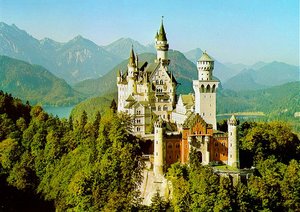Neuschwanstein
|
|
Neuschwanstein (German: Schloß Neuschwanstein, "new swan rock"; IPA pronounciation: /noiƒvanƒtaIn/) is a late 19th century castle in Germany, near Hohenschwangau and Füssen in southwest Bavaria, near the Austrian border.
Construction was started by King Ludwig II of Bavaria, known "Mad King Ludwig." It was designed by Christian Jank. The castle is located near his father's castle, Hohenschwangau castle. Due to his eccentricites and his perceived use of Bavarian funds—a myth, as Ludwig actually used his own money, some from his monarchal allowance, to finance the construction of the castle—Ludwig was removed from power before the castle was completed. In fact, the most famous view of the castle, seen in the photochrom from the 1890s below, would have been obscured because a large tower, which would have easily dwarfed the existing towers, was to have been constructed in the castle's courtyard. Soon after Ludwig's mysterious death (1886), the castle and its amazing interior was opened to the public. However, even today, much of the interior is unfinished.
Reflecting Ludwig's love of Wagnerian opera, many tapestries elaborate on themes presented in the operas.
Neuschwanstein, the (relatively) modern fairy-tale castle of Bavaria, inspired the modern fairy-tale castle at Disneyland, Sleeping Beauty Castle. The inspiration for the Cinderella Castles at other Disney parks is sometimes incorrectly attributed to Neuschwanstein. However, the basis for those designs is the Château d'Ussé in France.[1] (http://period8mayer.tripod.com/Usse.html)[2] (http://www.dlp-guidebook.de/Lands/Fantasyland/Attractions/ChateauDeLaBelle.htm)
Neuschwanstein was the castle that stood in for the castle in Vulgaria in the 1968 film Chitty Chitty Bang Bang.
Neuschwanstein_Castle_LOC_print.jpg
See also
External link
- Official website (http://www.neuschwanstein.de/english/index.htm)
Template:Commonsde:Neuschwanstein fr:Neuschwanstein ja:ノイシュヴァンシュタイン城 nl:Neuschwanstein sv:Neuschwanstein zh:新天鹅堡 he:נוישוונשטיין

